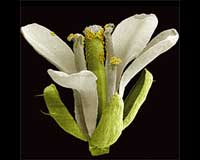 |
Madrid, Spain (SPX) Nov 17, 2010 Spanish and American researchers have conducted a mineralogical and chemical analysis to ascertain the origin of "terra rossa" soil in the Mediterranean. The results of the study reveal that mineral dust from the African regions of the Sahara and Sahel, which emit between 600 and 700 tonnes of dust a year, brought about the reddish soil in Mediterranean regions such as Mallorca and Sardinia between 12,000 and 25,000 years ago. "The first hint of the relationship between African dust and certain soils in the region of the Mediterranean is their reddish or reddish-brown colour, similar to that of African aerosol filters, caused by their clay content", co-author of the study and researcher at the Centre for Ecological Research and Forestry Applications (CREAF) at the Universidad Autonoma de Barcelona, Anna Avila explained to SINC. The study, which has been published in Quaternary Science Reviews, finds that African mineral dust additions "play an important role" in the origin of the soils (palaeosols) in the Mediterranean region, namely on the island of Mallorca. The results resemble those published regarding the soils on Sardinia, "which indicates the likelihood of Africa being a common source". In turn, "African dust explains the origin of the 'terra rossa' soils in the Mediterranean region located on top of mother carbonate rock," Avila added. In order to explain the origin of the reddish soils, the researchers considered three hypotheses: the non carbonate residual accumulation theory (soils are derived from the product of non carbonate weathering of the mother carbonate rock), the ascending 'sesquioxide' theory (accumulation of iron and aluminium hydroxides following capillary ascent from the bedrock) and the non-native soil accumulation theory (soil is formed by external sources, including airborne contributions). The first two hypotheses were discarded due to the geochemical composition of the trace elements of red soils and the underlying rock being different. "The hypothesis of non-native (external) contribution was reinforced due to the geochemical value of the land coinciding with that of African dust," the scientist stated. However, although the analysis of the soil indicates that African dust is the main contributor to the formation of the palaeosol, "the underlying rock also contributes, probably with residual quartz," the researcher added.
Origin and Destination of African Dust The largest sources of airborne mineral dust can be found in the Sahara and Sahel regions, with emissions of between 600 and 700 tonnes per year. The destination of this dust has recently aroused great interest among the scientific community for various reasons. Apart from the formation of red soils, African dust has "adverse effects on human health, such as respiratory problems and reduced visibility. It also arouses interest due to its implications where climate change is concerned, with the role that mineral aerosols play in the radiation balance, nutrient deposition and oceanic fertilisation", Avila explained. Muhs, Daniel R.; Budahn, James; Avila, Anna; Skipp, Gary; Freeman, Joshua; Patterson, DeAnna. "The role of African dust in the formation of Quaternary soils on Mallorca, Spain and implications for the genesis of Red Mediterranean soils" Quaternary Science Reviews 29(19-20): 2518-2543, septiembre de 2010.
Share This Article With Planet Earth
Related Links FECYT - Spanish Foundation for Science and Technology Farming Today - Suppliers and Technology
 Change In Temperature Uncovers Genetic Cross Talk In Plant Immunity
Change In Temperature Uncovers Genetic Cross Talk In Plant ImmunityColumbia MO (SPX) Nov 16, 2010 Like us, plants rely on an immune system to fight off disease. Proteins that scout out malicious bacterial invaders in the cell and communicate their presence to the nucleus are important weapons in the plant's disease resistance strategy. Researchers at the University of Missouri recently "tapped" into two proteins' communications with the nucleus and discovered a previously unknown level ... read more |
|
| The content herein, unless otherwise known to be public domain, are Copyright 1995-2010 - SpaceDaily. AFP and UPI Wire Stories are copyright Agence France-Presse and United Press International. ESA Portal Reports are copyright European Space Agency. All NASA sourced material is public domain. Additional copyrights may apply in whole or part to other bona fide parties. Advertising does not imply endorsement,agreement or approval of any opinions, statements or information provided by SpaceDaily on any Web page published or hosted by SpaceDaily. Privacy Statement |